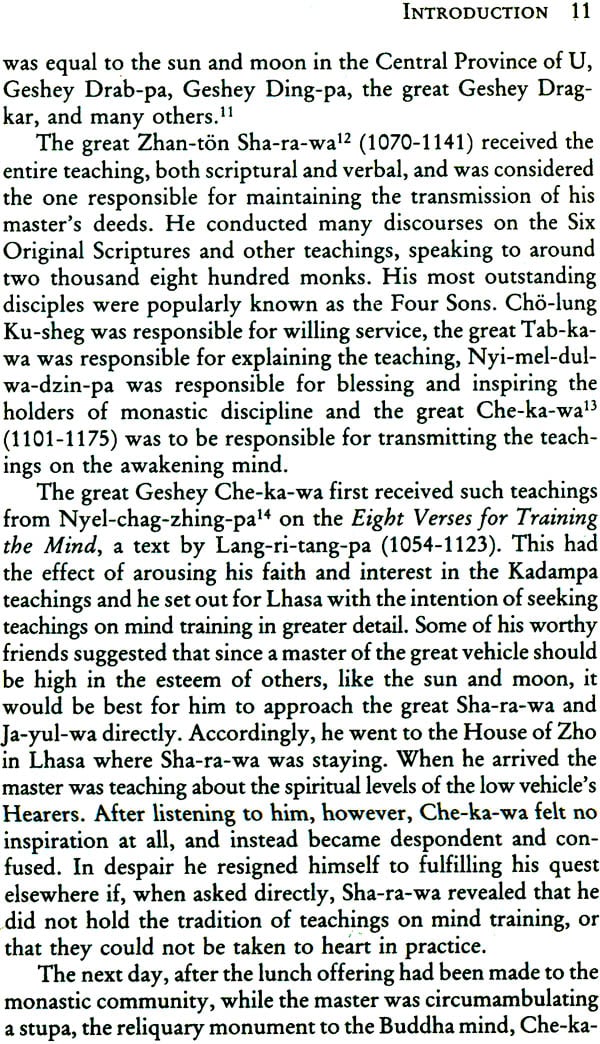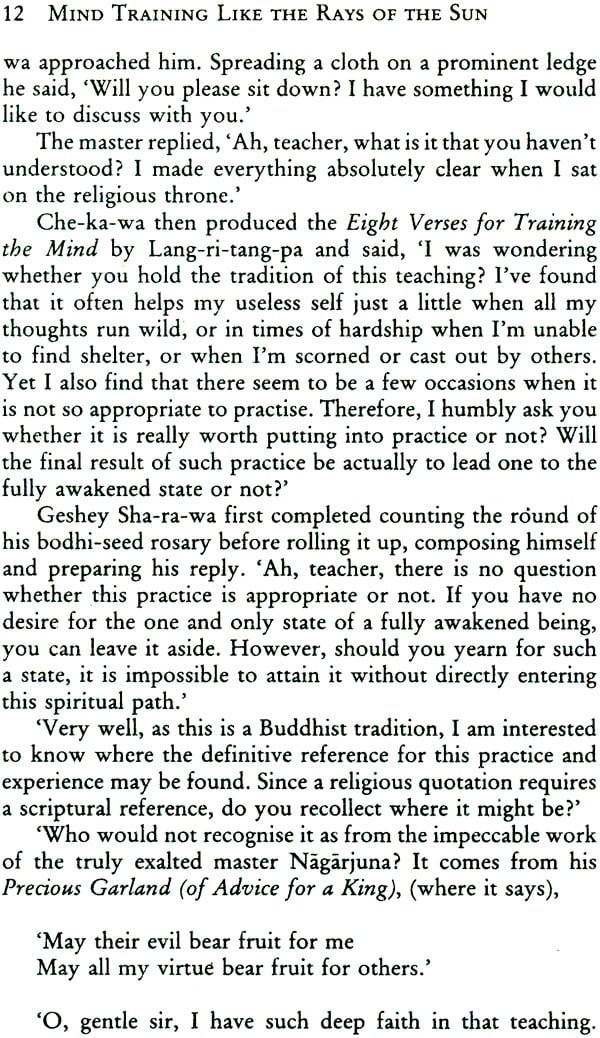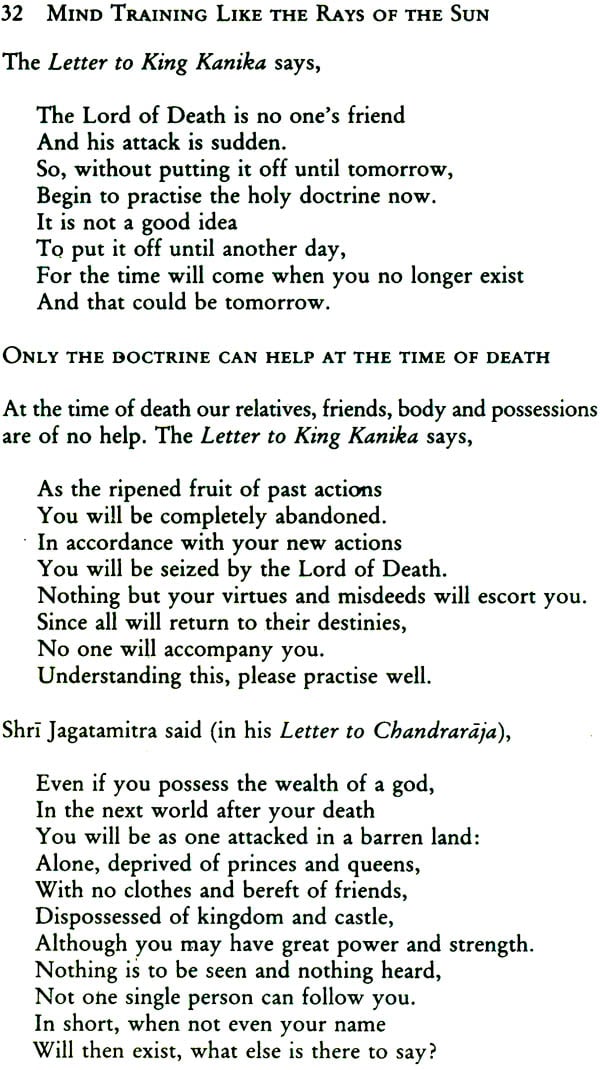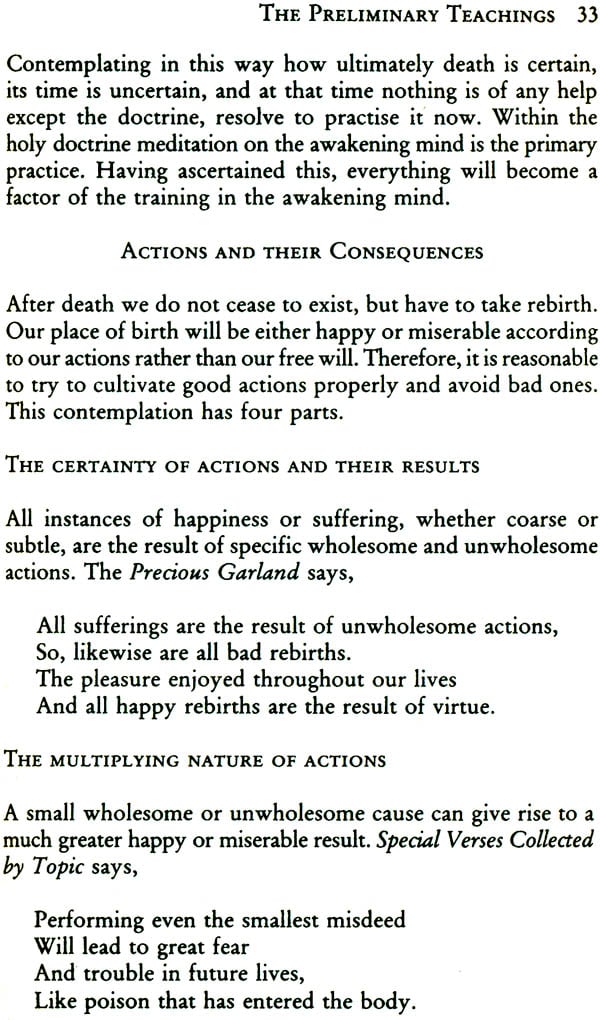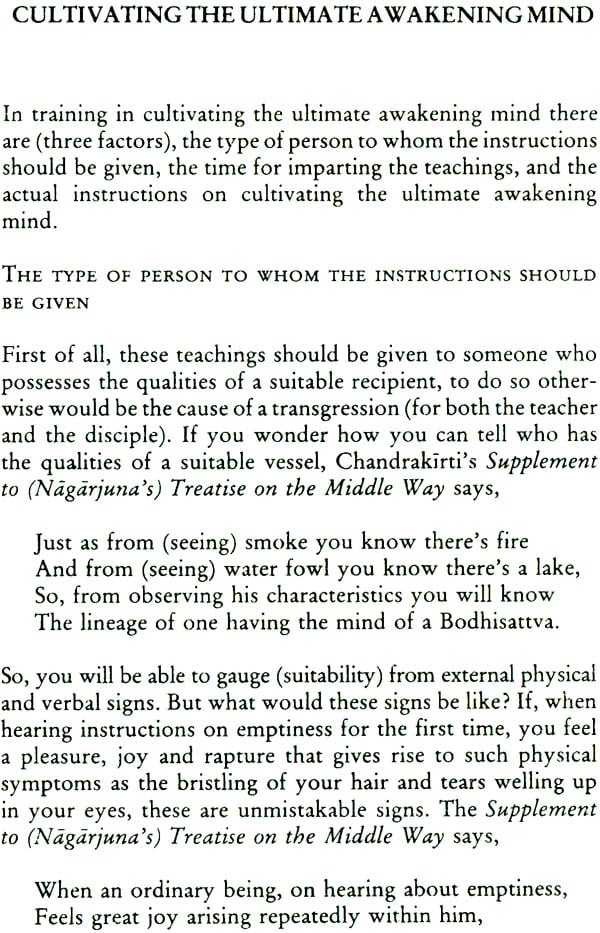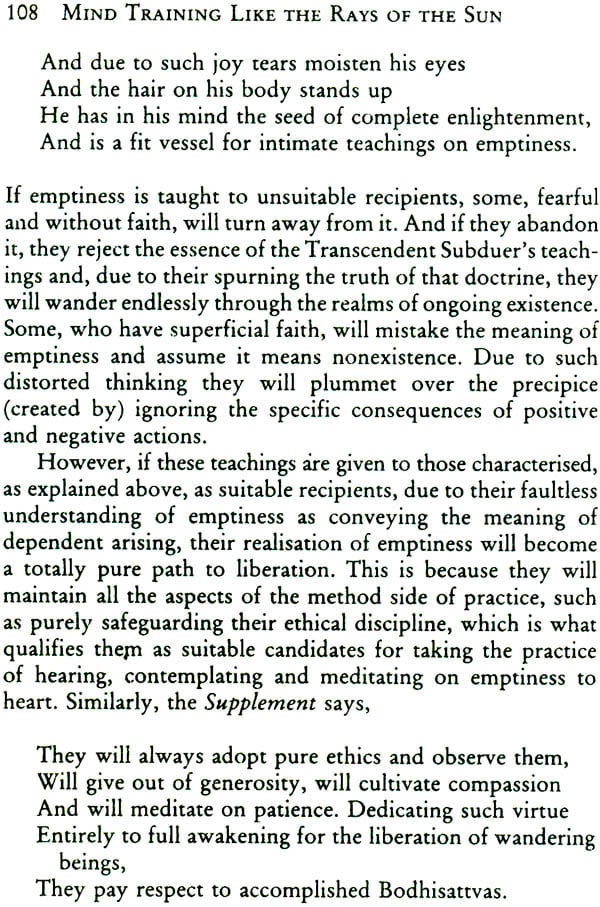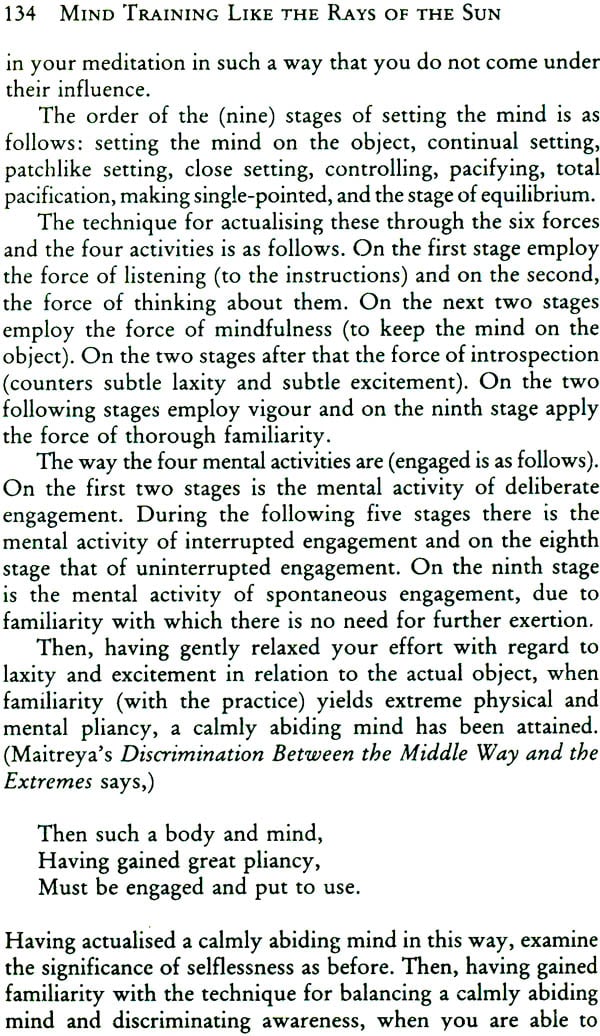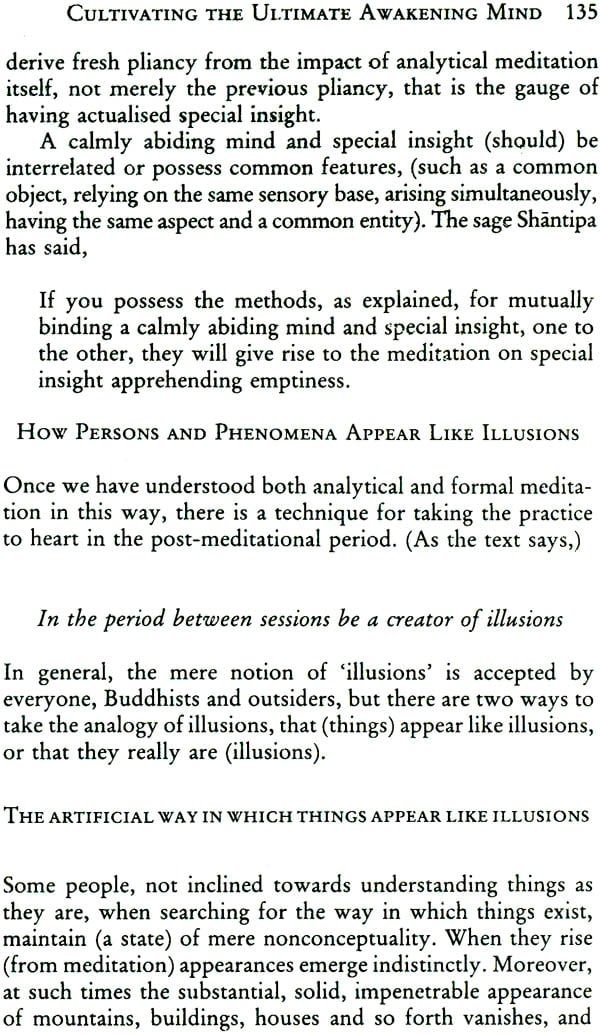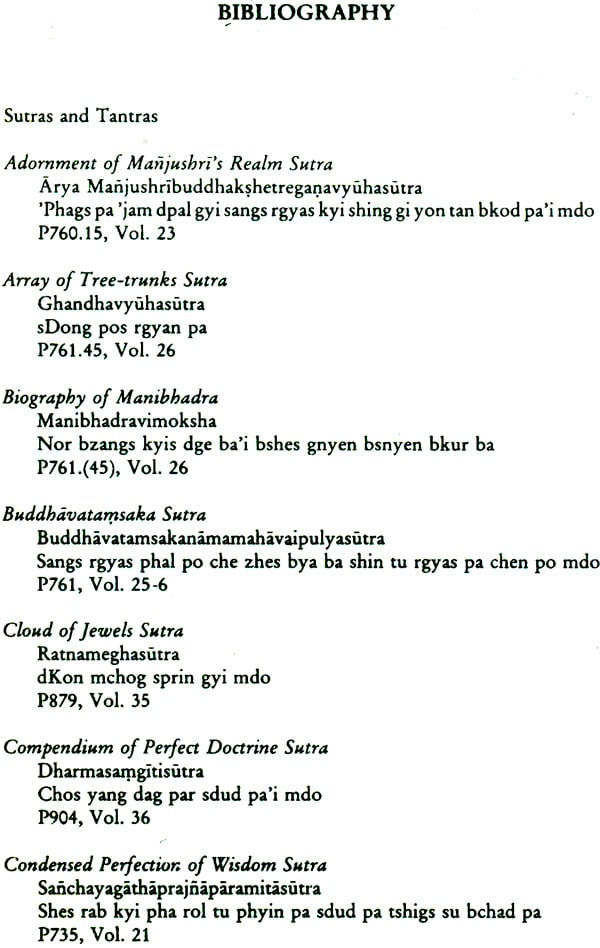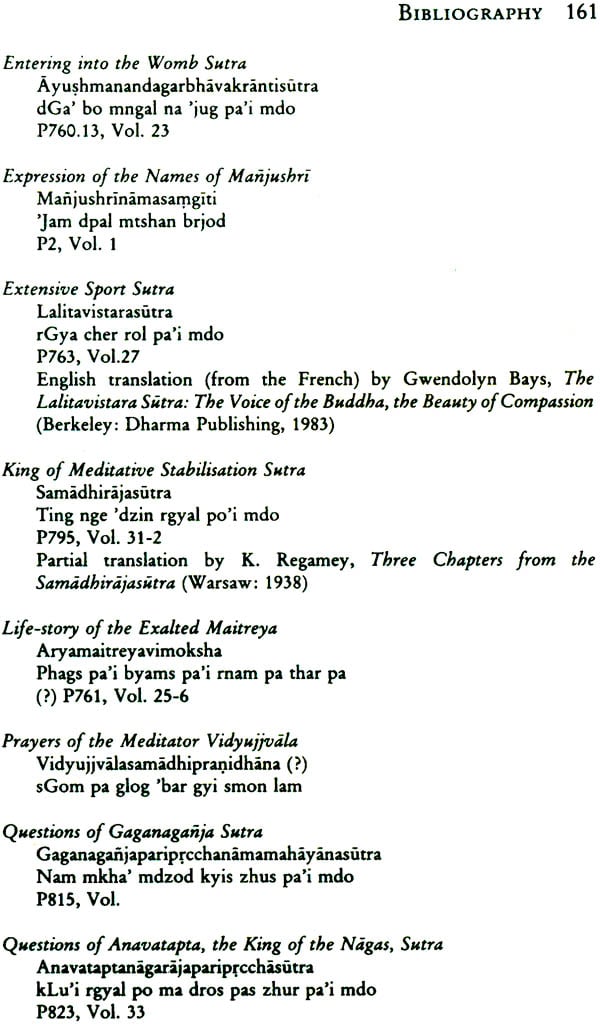
Mind Training Like The Rays Of The Sun
Book Specification
| Item Code: | IDK342 |
| Author: | Nam-kha Pel, Translated by Brian Beresford and Edited by Jeremy Russell |
| Publisher: | Library of Tibetan Works and Archives, New Delhi |
| Edition: | 2019 |
| ISBN: | 8185102716 |
| Pages: | 170 |
| Cover: | Paperback |
| Other Details | 8.5" X 5.5" |
| Weight | 230 gm |
Book Description
Foreword
LTWA is proud to present the translation into English of yet another important text in the Tibetan tradition of mind training, prepared by members of its Translation Bureau. The Mind Training Like Rays of the Sun (b Lo sbyong nyi ma'I'od zer) was composed by Nam-kha Pel, a close disciple of Je Tsong-kha-pa, and represents one of the most profound transmissions in the genre of mind-training, precepts. Its essential meaning is rooted in the practices of the Kadampa masters which were passed down to Tsong-kha-pa. In more recent times, the late Kyabje Yongzin Ling Rinpoche, Senior Tutor to His Holiness the Dalai Lama, and 97th occupant of the Ganden Throne, taught it frequently, especially at the Tibetan monastic universities re-established in South India. Having received this lineage from Kyabje Ling Rinpoche, His Holiness the Dalai Lama has also taught the text on several occasions in Dharamsala, Bodhgaya, and most recently in South India when the young reincarnation of his late tutor was enthroned at his monastery (Drepung Loseling).
The work of translating this text into English began on the recommendation and advice of Kyabje Yongzin Ling Rinpoche. Presenting the photo-offset film he said, 'Gyatsho, as this is my favourite text, I shall present the film of the manuscript to you for your archives, but you must ensure that it will be translated into English for the benefit of those who cannot read or speak Tibetan.' Thus, the project has carried his inspiration and blessings, and the burden of fulfilling it has weighed heavily on me over the years. Now that the translation is complete, I feel enormously relieved. A fresh memory of that event has been awakened in my mind though tinged with a feeling of sadness that he is no longer with us.
The task of translating this text into English was originally begun by Lobsang Choephel Gangchenpa and Alf Vial, who produced a draft version of the Preliminary Teachings section. Then it was taken up by Brian Beresford working with Lobsang Choephel Gangchenpa and Diane Short according to the instruction of Geshey Ngawang Dhargyey. Brian put a great deal of effort into refining the work and presented the manuscript of their translation to me. Finally, Jeremy Russell, working principally with Tsepak Rigzin, has revised and edited it into its present form. My grateful thanks go to all of them for their painstaking efforts and diligence in bringing this important work of translation to completion. I hope it will be of great benefit to the many scholars, students and meditators, as well as to psychologists, scientists and therapists, exploring the healing techniques found in Buddhist teachings and meditation.
Preface
It is often said that Tibetan Buddhism encompasses the whole of the Buddha's teaching, because it includes all three vehicles: the low, great and vajra vehicles. Of all the great Indian masters who came to Tibet one of the most influential was Atisha (982-1054 C.E.). He is praised amongst other things for reviving the monastic way of life, but his principal contribution to Tibetan Buddhism was to encourage the integration of the various strands of the Buddha's teaching and their implementation in actual practice.
He composed the Lamp to the Path of Enlightenment, which became the prototype for the 'stages of the path' (lamrim) literature. It was the first Tibetan text to give a complete survey of the whole path, from the practitioner's first entering into it up to the attainment of enlightenment. Because it is actually a concise text, although practitioners may be concentrating on a particular aspect of practice, by reading or reciting it they can review the whole path and so keep their final aim in perspective. Another feature of this presentation is that it does not simply reveal a step by step approach to enlightenment, but also presents the path in terms of the different kinds of practitioner. There are those of limited capacity, who are primarily concerned with their own good rebirth. There are those of middling capacity, who are aiming for their own liberation from cyclic existence and those of great capacity who are aiming to attain enlightenment for the sake of others.
This stages of the path presentation was absorbed and developed by all schools of Tibetan Buddhism. Je Tsong-kha-pa's Great Exposition of the Stages of the Path is notable for providing one of the largest and most exhaustive commentaries to Atisha's text. An indication of the great value attached to Atisha's Lamp for the Path and the integrated approach it presents can be gleaned from its reception in India. When the Tibetans first invited Atisha to visit Tibet, his abbot at Vikramashila monastery was extremely reluctant to let him go. However, after much persuasion he finally agreed on condition that the Tibetans ensured that he returned after a certain time. As it turned out, Atisha was unable to return within the stipulated period, but sent a copy of Lamp for the Path in his stead. The Indian scholars at Vikramashila were for although they had lost Atisha, if he had not gone to Tibet he would not have written it presents can be gleaned from its reception in India. When the Tibetans first invited Atisha to visit Tibet, his abbot at Vikramashila monastery was extremely reluctant to let him go. However, after much persuasion he finally agreed on condition that the Tibetans ensured that he returned after a certain time. As it turned out, Atisha was unable to return within the stipulated period, but sent a copy of Lamp for the Path in his stead. The Indian scholars at Vikramashila were so impressed with it that they felt they had been compensated, for although they had lost Atisha, if he had not gone to Tibet he would not have written it.
Another of Atisha's major contributions to Tibetan Buddhism was the mind training tradition. He received this from one of his teachers, Dharmamati, a master from Sumatra. This text refers to him as Serlingpa-man from the Golden Isle or man from Sumatra. Of all his many gurus, Atisha regarded this teacher with especial respect and affection because under his tutelage he learned how to actually bring about the awakening mind, which is the key point of the mind training teachings.
To emphasise the value they place on these teachings Tibetans commonly recount the great hardship that Atisha underwent to receive them, stressing the thirteen month voyage and the twelve years he spent with his master in Sumatra. And recalling Atisha's esteem for him the Tibetans in turn hold him in great respect.
The mind training teaching teachings are a great vehicle instruction, because they are mostly concerned with developing the awakening mind, the altruistic mind of enlightenment. They are directed primarily towards the practitioner of great capacity. They deal essentially with transforming our mental attitudes. Firstly, they are concerned with transforming our attitudes towards other beings. One of the greatest obstacles to both ordinary happiness and spiritual progress is self-centredness. While the door to the great vehicle is the aspiration to highest enlightenment based on a deep seated wish to help others in the best possible way, most of us have just the opposite attitude and are predominantly concerned with our own interests. The mind training teachings provide a variety of techniques for subduing this fundamental selfishness and transforming it into concern for others.
One of the special features of the mind training teachings is the advice to transform adversity into advantage. Even though we may have transformed our motivation and outlook in positive ways so that we actually want to help others-through seeing the disadvantages of selfishness and so on-we are continually beset by obstacles and difficulties which prevent our putting our good intentions into practice. So not only do these instructions help us transform whatever difficulties come our way into something valuable. In addition the mind training teachings help us recognize that our real enemy is our own disturbing emotions. As well as identifying them, they provide us with ways of opposing them directly.
The final set of attitudes that mind training helps us change are those concerned with our view of reality. It is a common Buddhist assertion that our mistaken view of the way things exist is the source of our problems. The great vehicle tenets say that the fault lies in viewing things as being truly existent. The mind training teachings contain the advice to view all phenomena as being like illusions.
His Holiness the Dalai Lama has remarked that these simple but far-reaching techniques of mind training, particularly those with regard to concern for others and turning adversity to advantage, have virtually become part of the Tibetan character. It is just these traits that have enabled them not only to maintain their identity and spirit in the face of great difficulties, but also to rebuild their lives and their culture in exile.
The stages of the path and mind training are two themes of Atisha's presentation of Buddhist doctrine. A third consisted of classic Buddhist scriptures, referred to here as the six original scriptures, including such works as Shantideva's Guide to the Buddhisattva's Way of Life and Compendium of Trainings. When the teachings associated with these themes were passed down, from Drom-ton-pa, Atisha's principal disciple and founder of the Kadampa order, the lineages became divided and were preserved in different ways in different traditions. It was not until Je Tsong-kha-pa that these lineages were united in one person once more. He referred to the order that he founded as the new Kadampas-signifying that it emulated the earlier Kadampa masters who followed Atisha. Like them, he emphasized the necessity of practicing all the Buddha's teachings, adopting the Kadampa outlook of observing the low vehicle instructions in your external behaviour, the great vehicle in your inner attitude and the tantric path in secret.
The Mind Training like the Rays of the Sun exemplifies Tsong-khapa's presentation of mind training. The author Nam-kha Pel, as he mentions in his the introduction, received the lineage of the explanation of the Seven Point Mind Training, which is the fundamental text here, from various sources including Je Rinpoche, his principal teacher. What is distinctive about this presentation is that he has managed to combine both the mind training instructions as they are recorded in Geshey Che-ka-wa's text the Seven Point Mind Training with the pattern of the stages of the path.
Perhaps because these instructions are part of a vibrant oral tradition, there are many slightly different editions of the basic Seven Point Mind Training. This can be seen clearly from a comparison of Nam-kha Pel's edition, which has been extracted and presented here before the text of the Rays of the Sun and thog-me Zang-po's edition which is placed at the end. There are some discrepancies between individual lines, but the most significant difference is that, whereas most of the earlier editions begin with the ultimate awakening mind and a discussion of emptiness, the Rays of the Sun version follows the stages of the path pattern and places this section last. Similarly, where the basic text begins simply 'Homage to great compassion' Nam-kha Pel opens his commentary with a prostration to 'the infinitely compassionate spiritual masters' reflecting the first point of the stages of the path approach-the importance of cultivating the spiritual master.
So this edition is unusual in combining the features of the stages of the path and the mind training traditions, two of the major themes of Atisha's presentation of the doctrine. In addition, by also making copious quotations from various classic Indian scriptures it in effect incorporates the third theme too.
In his introduction the author quotes. Tsong-kha-pa as pointing out that there appeared to be variations of length and sequence of the basic text, the Seven Point Mind Training, and that it would be beneficial if these were clarified. Even though he did so, variations persisted into this century, for we find Pha-bong-kha Rinpoche saying much the same thing in 1935. He had felt for some time that it would be useful to have a definitive edition of the Seven Point Mind Training. His consequent version was drawn from sources already accepted as belonging to the Gelug tradition. Found among Trijang Rinpoche's Miscellaneous works, it is indeed useful because it I clearly laid out under simple headings and includes full enumerated lists of the commitments and precepts of the practice of mind training. For this reason it has also been included here at the end of the book.
Now, whatever can be said about his text, little is known about the author. Horton Nam-kha Pel was a direct disciple of Je Tsong-kha-pa and in the latter's Collected Works Nam-kha Pel-sang's name is often mentioned as the scribe. This has lead to the suggestion that Mind Training Like the Rays of the Sun may be something like a transcription of Tsong-kha-pa's explanation. If this were so it would be valuable for representing how he actually taught as opposed to how he wrote, of which there is ample evidence.
It happens that among Tsong-kha-pa's Collected Works there are two letters to Nam-kha Pel. In one of them Je Rinpoche thanks him for a present he has sent and addresses him as 'one with clear intelligence whose faith is firm'. He praises his generosity and he comments that he has heard much, from which we can assume that he has listened to many of Je Rinpoche's teachings. It seems that Nam-kha Pel had sent him a statue of a Bodhisattva and a text of the Guhyasamaja Tantra beautifully wrapped in orange coloured banners. Je Rinpoche comments that it was delivered intact and thanks him for his letter which was full of good and agreeable worlds. He goes on to remark, 'You say that what I taught you before was useful and that you are practicing what I taught. You request me for more teachings. But I have no more to teach you than what I taught before, there's nothing better than that. However, if you listen with respect and interest again and again to what is taught well, then just as drops of water falling repeatedly on a rock will eventually wear out a channel, so you will derive benefit.'
There is a second letter the gist of which is that Je Rinpoche says, 'In reply to the letter sent by the intelligent novice monk, the fully ordained monk Lobsang Drakpa, who has heard a great deal, and who is getting rid of negative traits, has this to say: You say you have pure thoughts, this is good, your mind is pure.' What we can conclude is that Je Rinpoche treated Nam-kha Pel with affection and praised him for his practice.
His Holiness the Dalai Lama mentioned when he taught the Mind Training Like the Rays of the Sun in Dharamsala in 1985 that he had received the explanation and transmission of this text from his Senior Tutor, the precious Ganden Throne-holder, Yongzin Ling Rinpoche. He in turn had received it from an Amdo lama called Minyak Rinpoche, a very good lama, who was an old monk with a huge red nose. His Holiness said that he received it from Yongzin Ling Rinpoche after they had arrived in India. It was Ling Rinpoche's favourite mind training text and he was responsible for popularizing it. He taught it a couple of times at the re-established monasteries in South India and once here in Dharamsala. His Holiness went on to say that the basic theme of the text is the generation of an awakening mind, a greater concern for others than for yourself, which is the central pillar of the great vehicle teaching. So, this mind training represents the very core of the great vehicle practitioner's practice. Not only does it provide an understanding of the points to be followed, but it describes how to actually apply them.
Although Brain Beresford and others had already translated the majority of this work, there were still some folios missing thoroughly revised and edited. I would like to acknowledge a number of people who helped me in doing this. The members of the LTWA's Translation Bureau, specifically Tsepak Rigzin, Tenzin Dorje, and Thubten Tashi assisted in completing and revising the translation. Ven. Yelo Tulku and Lobsang Shastri of the Library's manuscript room offered patient bibliographical help. In particular I wish to thank Geshey Sonam Rinchen and Ruth Sonam for taking the time to unravel some of the knotty problems in the presentation of the ultimate awakening mind section. Finally, thanks to LTWA's Director, Mr. Gyatsho Tshering, for his fathomless patience and long-standing interest in the project.
Back of the Book
The mind training teachings are a great vehicle instruction, because they are mostly concerned with developing the awakening mind, the altruistic mind of enlightenment. They are directed primarily towards the practitioner of great capacity, and deal essentially with transforming our mental attitudes.
One special feature of the mind training teachings is the advice to transform adversity into advantage. So, not only do these instructions help us open out towards other beings, but they also help us transform whatever difficulties come our way into something valuable.
The Mind Training Like The Rays of the Sun exemplifies Tsong-khapa's presentation of mind training. The author, Nam-kha Pel, as he mentions in his introduction, received the lineage of the explanation of the Seven Point Mind Training, which is the fundamental text here, from various sources including Je Rinpoche, his principal teacher. What is distinctive about this presentation is that he has managed to combine both the mind training instructions as they are recorded in Geshey Che-ka-wa's text with the pattern of the Stages of the Path.
| FOREWORD | vii |
| PREFACE | ix |
| Part I: Introduction and Preliminary Teachings | 1 |
| THE SEVEN POINT MIND TRAINING | 3 |
| AUTHOR'S HOMAGE AND REQUEST | 6 |
| A PRAYER OF DEVOTION | 6 |
| INTRODUCTION | 8 |
| An Historical Account of the Teaching | 8 |
| The Unique Features, Values and Extraordinary Function of this Secret Instruction | 14 |
| Part II: Explanation of the Teaching | 17 |
| CONTEMPLATION OF THE PRELIMINARY TEACHINGS | 19 |
| Life as a Free and Fortunate Human Being | 20 |
| How to Think About the Brevity of This Life, Death and Impermanence | 26 |
| Actions and Their Consequences | 33 |
| The Drawbacks of Cyclic Existence | 36 |
| CULTIVATING THE CONVENTIONAL AWAKENING MIND | 42 |
| Actual Techniques for Cultivating the Awakening Mind | 45 |
| Meditation on Love | 59 |
| Meditation on Compassion | 72 |
| Instructions Concerning the Five Precepts that are Factors of the Training | 81 |
| Transforming Adverse Circumstances into the Path | 81 |
| The Integrated practice of a Single Lifetime | 84 |
| The Measure of Having Trained the Mind | 88 |
| The Irreversible Commitments of Mind Training | 91 |
| The Precepts of Mind Training | 98 |
| CULTIVATING THE ULTIMATE AWAKENING MIND | 107 |
| Actual Instructions on Cultivating the Ultimate Awakening Mind | 110 |
| How to Determine the Selflessness of Persons | 121 |
| How to Determine the Selflessness of Phenomena | 129 |
| How Persons and Phenomena Appear Like Illusions | 135 |
| Part III: Appendices | 141 |
| THE SEVEN POINT MIND TRAINING | 143 |
| Thog-me Zang-po's Edition | 143 |
| Pha-bong-kha Rin-po-che's Edition | 146 |
| OUTLINE OF THE MIND TRAINING LIKE THE RAys OF THE SUN | 151 |
| NOTES | 155 |
| BIBLIOGRAPHY | 160 |
| SANSKRIT AND TIBETAN TREATISES | 163 |
| OTHER RELATED WORKS | 169 |
